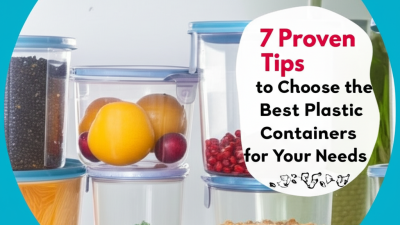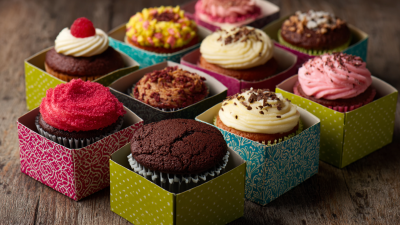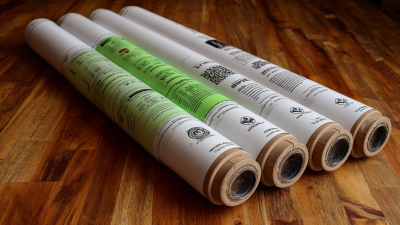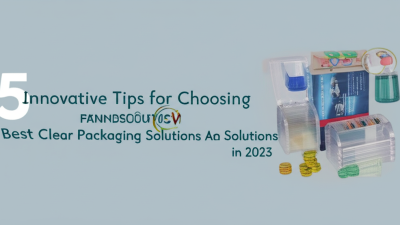7 Proven Tips to Choose the Best Clear Plastic Containers for Your Needs
In recent years, the demand for clear plastic containers has surged, driven by both consumer convenience and the growing awareness of sustainability in packaging. According to a report by Research and Markets, the global plastic packaging market is projected to reach $650 billion by 2027, with clear plastic containers comprising a significant share due to their versatility and visibility. These containers not only allow consumers to easily identify contents but also provide robust protection against contamination, making them essential for both food storage and organization. As industries ranging from food service to personal storage continue to innovate, choosing the best clear plastic containers tailored to specific needs can enhance efficiency and sustainability. This blog will provide you with seven proven tips to make an informed selection that meets your requirements while maximizing the benefits of these indispensable tools.

Essential Factors to Consider When Selecting Clear Plastic Containers
When selecting clear plastic containers, there are several essential factors that can significantly influence your choice. First and foremost, consider the container's purpose. According to a 2021 survey by the Packaging Association, 62% of consumers expressed that functionality is their top priority when choosing storage solutions. Whether it’s for food storage, organizing tools, or craft supplies, identifying the intended use will help narrow down your options.
Another crucial aspect is the material quality. Opt for BPA-free containers, as reports from the Environmental Protection Agency highlight the health risks associated with BPA exposure, especially for food-related containers. Additionally, durability should be a top consideration—choose containers made from polycarbonate or high-density polyethylene, known for their strength and resistance to impact, as noted in a 2020 study published in the Journal of Plastics.
Lastly, think about stackability and design. Containers that are designed for easy stacking not only save space but also enhance organization. In fact, the same Packaging Association survey found that 48% of consumers value space-saving designs in their purchasing decisions, indicating that aesthetic appeal goes hand-in-hand with functionality.
Understanding Different Types of Clear Plastic Materials and Their Uses
When it comes to selecting clear plastic containers, understanding the different types of plastic materials available can significantly influence your choice. Polyethylene terephthalate (PET) is a popular option due to its clarity and strength, making it ideal for food storage and containers that require visibility. It is lightweight, shatter-resistant, and recyclable, which enhances its appeal for both personal and commercial use. Additionally, PET's ability to withstand temperature variations makes it suitable for a variety of applications, from beverages to dry goods.
Another common material is polycarbonate (PC), known for its exceptional durability and resistance to impact. This type of plastic is often used in environments where high strength is necessary, such as medical and industrial settings. Moreover, polycarbonate containers can withstand extreme temperatures, making them versatile for both hot and cold items. However, it’s essential to consider potential health concerns associated with BPA in some polycarbonate products, leading consumers to explore BPA-free alternatives like Tritan, which offers similar benefits without the associated risks. Understanding these different materials is crucial in making informed decisions when purchasing clear plastic containers tailored to your specific needs.
How Size and Shape Impact the Functionality of Your Containers
When it comes to selecting the best clear plastic containers, understanding how size and shape impact functionality is crucial. Proper sizing not only accommodates your specific storage needs but also improves accessibility and organization. For instance, taller containers can maximize vertical space, making them ideal for storing pantry items like grains, while wider, shallower containers are better suited for easier access to frequently used items. According to market forecasts, the household food storage container market is anticipated to grow from approximately $29 billion in 2025 to $47 billion by 2035, driven largely by consumer demand for innovative storage solutions that cater to diverse lifestyles and preferences.
Shape also plays a significant role in the performance and usability of storage containers. It can affect how efficiently you can stack or arrange containers in your kitchen or pantry. Recent tests on food storage containers highlight that design influences not only aesthetic appeal but also ease of cleaning and maintenance. Research shows that containers with rounded edges tend to offer better cleaning efficiency compared to those with sharp corners, as residue can accumulate in less accessible areas. Therefore, when choosing clear plastic containers, consider both size and shape carefully to ensure they meet your functional requirements while also enhancing your space's organization.
Budgeting for Quality: Balancing Cost and Durability in Container Choices
When selecting clear plastic containers, one of the most critical factors to consider is balancing cost with durability. According to industry reports, the average consumer spends around $100 annually on food storage solutions, making it imperative to choose containers that will withstand frequent use. Many budget options may seem appealing at first glance, but cheaper materials can lead to rapid wear and tear, resulting in the need for replacements that could ultimately cost more over time.
Durability plays a key role in the longevity of plastic containers. Research indicates that high-quality containers, although initially pricier, can last up to five times longer than their less expensive counterparts. Investing in well-made options not only supports effective food preservation but also helps reduce waste.
Additionally, features such as airtight seals and BPA-free materials enhance the usability and safety, ensuring that your food stays fresh without compromising your health. As you navigate the market, remember that an informed choice in quality can save you money and provide peace of mind for the long haul.
Tips for Organizing and Storing Items Effectively in Clear Plastic Containers
When it comes to organizing and storing items effectively, clear plastic containers serve as a versatile solution. Their transparency allows for easy visibility of contents, which can significantly reduce the time spent searching for items. To maximize their effectiveness, it’s essential to select the right size and shape of containers. Smaller bins are great for accessories or office supplies, while larger ones are perfect for storing seasonal clothing or bulk items. Utilizing various sizes can help you maintain a tidy and organized space.
Labeling your clear plastic containers is another crucial tip for effective storage. By indicating what each container holds, you streamline the process of retrieving items, making your routines more efficient. Additionally, consider incorporating stackable options to make the most of vertical space; this can help keep your environment clutter-free while optimizing storage efficiency. With the right containers and smart labeling strategies, you can achieve a well-organized space that caters to your specific needs.
7 Proven Tips to Choose the Best Clear Plastic Containers for Your Needs
| Tip Number | Tip Description | Container Size | Best Use Case |
|---|---|---|---|
| 1 | Consider the material quality of the container. | Small (1-2 quarts) | Storing spices or small kitchen items. |
| 2 | Choose containers with airtight lids for freshness. | Medium (3-5 quarts) | Ideal for dry food storage. |
| 3 | Select transparent materials to see contents easily. | Large (6-10 quarts) | Great for organizing toys or craft supplies. |
| 4 | Look for stackable designs to save space. | Various | Utilize in pantries or closets for efficient storage. |
| 5 | Consider the shape that fits your space. | Custom Sizes | Perfect for under-sink storage solutions. |
| 6 | Check for dishwasher-safe options for easy cleaning. | Medium to Large | Ideal for meal prep containers. |
| 7 | Opt for containers with measurements marked for convenience. | Various | Useful for baking and cooking needs. |
Related Posts
-

Creative Ideas for Best Cupcake Packaging That Stand Out
-

The Future of Sustainable Best Poster Tubes for Global Buyers
-

Troubleshooting Issues with Plastic Tubes with Caps: What Global Buyers Need to Know
-

7 Best Ways to Choose the Right Packing Tubes for Your Business
-

5 Innovative Tips for Choosing the Best Clear Packaging Solutions in 2023
-

Exploring Unique Alternatives to Traditional Tube Boxes for Your Packaging Needs
